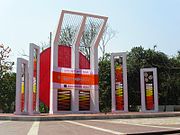Eid ul-Fitr
As the most important religious festival for the majority Muslims, the celebration of Eid ul-Fitr has become a part of the culture of Bangladesh. The Government of Bangladesh declares holiday for three days on Eid-ul Fitar. People living in towns having their families or parents in villages go to their country homes to meet relatives and celebrate the festival together. All outgoing public transport from the major cities become highly crowded and in many cases the fares tend to rise in spite of government restrictions.
On Eid day, Eid prayers are held all over the country, in open areas like fields or else inside mosques. In Dhaka, the largest Eid prayer is held at the national Eidgah. All major mosques including the Baitul Mukarram also holds prayers. The biggest congregation of Bangladesh is held at Sholakia in Kishoreganj, where about half a million people join the Eid prayer.[3] After the Eid prayers people return home, visit each other's home and eat sweet dishes called shirni. Throughout the day gentlemen embrace each other. It is also customary for junior members of the society to touch the feet of the seniors, and seniors returning blessings (sometimes with a small sum of money as a gift).
In the rural areas Eid festival is observed with great fanfare. In some areas Eid fares are arranged. Different types of games including boat race, kabbadi, other traditional Bangladeshi games as well as modern games like football and cricket are played on this occasion.
In urban areas people play music, visit each other's houses and eat special food. Watching movies and television programs has also become an integral part of Eid celebration in urban areas. All local TV channels air special program for several days for this occasion.






